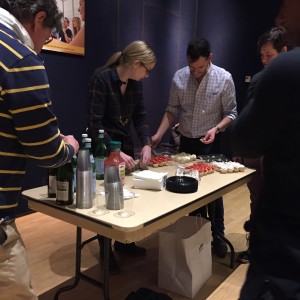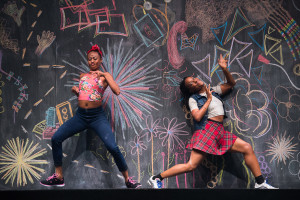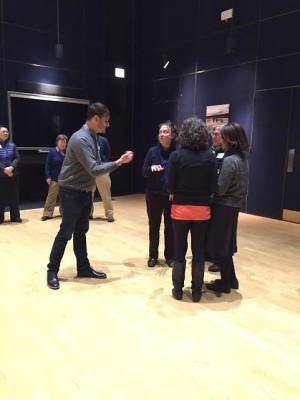Why are Beethoven’s String Quartets widely regarded as his “greatest compositions”?
As a French horn performance major at the University of Michigan, I’ve been immersed in chamber music of all stripes, from classical duos to contemporary dectets. At U-M, my (brass and woodwind) colleagues and I strayed away from playing music of Beethoven, Haydn and Mozart in our chamber groups, while other (string) chamber groups played only that music. How can they play Beethoven’s music all the time?, I’d think to myself. Doesn’t it get boring? After four years of wondering, I’ve finally discovered that the answer to that question is “no”, and here’s why.
Beethoven was arguably the most critical figure in creating the movement from the classical era to the romantic era. Take a listen and you’ll see that his string quartets are easily the most intimate of his works. That’s because they involve only four voices, each with its own personality. For audience members, Beethoven’s string quartets are a keyhole to Beethoven’s genius during some of his most vulnerable times.
Beethoven took the string quartet to the next level, a level, perhaps, too high for many people of his time. While his predecessors like Mozart and Haydn wrote incredible string quartets as well, Beethoven had something new and exciting to offer in his string quartets. He added a new depth, variation, and complexity. Beethoven’s string quartets are often regarded as “characteristically unique.”
“They are not for you, but for a later age!” So wrote Ludwig van Beethoven about his Op. 59 quartets, which will be performed in Ann Arbor as part of a complete Beethoven string quartet cycle by the Takács Quartet over six concerts (three weekends) in the 2016-17 season.
Beethoven’s quartets are divided into three periods: early, middle, and late. His early quartets, nos. 1-6, are said to be reminiscent of Haydn and Mozart. The first three (nos. 7-9) of his middle quartets (nos. 7-11) are nick-named the Razumovsky quartets, as Count Razumovsky commissioned them. Beethoven’s sad and dismal last few years of life are well-reflected in his late quartets, nos. 12-16. Take a listen to the beginning of nos. 12-15 and you’ll hear that each has a slow, chorale-like opening, not something we hear in the openings of Beethoven’s early and middle quartets.
As I’m writing this blog post, I’m listening to all of Beethoven’s string quartets. For me, what’s prominent in each is genuine emotion. There are also dynamic contrasts that are characteristic of Beethoven’s symphonies. Each of his string quartets sound almost like mini-operas.
Take a listen to the fourth movement of Beethoven’s Quartet in B-flat Major, no. 6 – op. 18. The first section is marked as “La Melancholia Adagio” (played at a melancholy, slow tempo) and within the same movement, the second section is marked “Allegretto quasi Allegro” (played at a quicker tempo in a lighter, more dance-like manner). Within just one movement of one of Beethoven’s quartets, we experience two polar opposite tempos, styles, and emotions.
Here’s a special challenge for you: Try listening to the Takacs Quartet’s recording of Quartet in B flat major – op. 130, movement 5 without shedding a tear. I will say that, as a brass player, sometimes I can’t stay engaged when listening to string music, but the musical genius and emotion that Beethoven poured into his string quartets is impossible for me to ignore.
But what else makes these quartets so impossible to ignore? And what else goes into making these quartets so highly regarded as Beethoven’s best works? The musicians that play them, of course!
How do today’s musicians do justice to Beethoven’s String Quartets?
In the TEDx Talk above, Edward Dusinberre, first violinist of the Takacs Quartet, says that the primary goal of the Takacs Quartet is to “try to communicate a very strong musical character.”
While Beethoven may give hints by writing “specific character instructions” (as Dusinberre calls them), it’s up to the musician to interpret those instructions. Dusinberre mentions that the quartet must work individually and as a group to discover what style works best in effectively communicating a specific character instruction written at the beginning of the piece. This can be done by changing the timbre, articulation, dynamics, tempo, and musical phrasing.
There are only four voices in a string quartet. So, there are only four musicians, which adds to the intimacy of Beethoven’s string quartets.
But passion is what fuels the performance of the Beethoven String Quartet cycle, the same passion that fuels Beethoven’s writing of the piece. Through style, passion and communication, Beethoven’s string quartets are kept alive today.
The Takacs Quartet has released several albums and recordings of high merit, but the albums that have received the most recognition are their Beethoven String Quartet albums. These albums (one of which was awarded the 2002 GRAMMY for best chamber music recording) have received numerous awards and are highly praised.
Edward Dusinberre’s book, Beethoven for a Later Age: Journey of a String Quartet gives readers insider information on the journey of the Takacs Quartet as well as the journey of Beethoven’s composing his string quartets.
So, the answer is “no.” Beethoven’s music does not get boring for string chamber musicians, because they have learned to enjoy the process of bringing his music to life. As a musician, I am privileged enough to be able to musically tell a story. Beethoven’s string quartets and the Takacs Quartet have taught me — a brass player! — that the key to successfully telling the story is to engage the audience by communicating with them through my musical styles and through my passion.
Ann Arbor audiences can expect to experience this artist-to-audience connection during the Takacs Quartet’s performances of the Beethoven String Quartet cycle with UMS for the 2016-2017 season. As Dusinberre said, “The performance can create an atmosphere on stage where the audience doesn’t feel inhibited [to express themselves]”, an atmosphere that the Takacs Quartet is sure to bring to Ann Arbor.
UMS Night School Session 5 Recap: Reflection and Graduation
Please note: This post is a part of series about the free and open to the public UMS Night School. UMS Night School: Constructing Identity runs January 18-February 15, 2016.
On Monday, February 15, I attended our last UMS Night School session of the season. We chatted about the 2016 edition of UMS Night School, and our special guest speaker was Jennifer Harge, Artistic Director of Harge Dance Stories.
We began class with a different spin on the usual movement activity. Harge asked us to create two movements: one that reflected what others think of us, and another that reflected our self-image. Harge then asked us to draw upon a childhood memory to act it out. The purpose of this activity was to get us thinking about the difference between performing the movement as a child and performing it as an adult. This led into a discussion of Camille A. Brown’s Black Girl–Linguistic Play, which was performed this past Saturday, February 13 at 8pm in the Power Center.
We talked about how Brown’s work challenged the perception of dance. Harge explained that the work challenged the dancers in the show because they had to let go of everything they had been trained to do as dancers; they had to become naïve in order to successfully portray Brown’s experience as a young black girl.
One Night School student said that Brown’s work made him think of the old Peanuts Cartoons–the characters are all children, yet they each have their own idiosyncrasies as adults do.
 We ended by celebrating with a raffle, a perfect attendance award, and cupcakes!
We ended by celebrating with a raffle, a perfect attendance award, and cupcakes!
I’ve learned a lot about constructing identity as an artist and an audience member, and I’ve been introduced to several new and exciting ideas. It’s also been nice to step away from school and engage with community members from around the area. In the future, I strongly suggest that you experience at least one of these classes; the worst thing that could possibly happen by trying it just once is that you won’t win the perfect attendance award ;)!
Details about next season’s UMS Night School will be available in Summer 2016.
UMS Night School: Constructing Identity Together – Session 4 Recap
Please note: This post is a part of series about the free and open to the public UMS Night School. UMS Night School: Constructing Identity runs January 18-February 15, 2016.
This past Monday, I attended my second UMS Night School session. For this week’s session, we discussed this past weekend’s performances by Tanya Tagaq and Taylor Mac.
The discussion focused on how Taylor Mac and Tanya Tagaq made their performances accessible and relatable to audiences; some of the UMS Night School participants noted that Taylor and Tanya’s performances were “welcoming” and “inviting.” Talk about constructing identity together! These two artists really went above and beyond in engaging their audiences, whether it was physically (like Taylor Mac) or emotionally (like Tanya Tagaq), or both!
We then moved into a discussion of upcoming performance of Camille A. Brown’s Black Girl–Linguistic Play, occurring this Saturday, February 13, 2016 at 8 pm in the Power Center. This time around, the discussion was lead by guest speakers Robin Wilson (Associate Professor of Dance) and three University of Michigan students in the School of Dance: Michael Parmelee, DeeDee Fattore, and Selena Moeljadi, all of whom had the experience of being involved in Camille A. Brown’s City of Rain.
Camille A. Brown’s City of Rain, performed by the Mason Gross School of the Arts.
While the video above does not feature our awesomely-talented guest speakers, it does feature some of the emotion that our speakers said they’ve learned to channel in their performance of City of Rain, which was featured in the University of Michigan Dance Department’s most recent showcase, Momentum, which ran from February 4-7, 2016.
Robin Wilson shared her experience of what it was like to be the Rehearsal Director for City of Rain, while the students shared their experience of being in the midst of City of Rain.
What did you learn?
Jim asked the guest speakers what they learned from their experiences of City of Rain. Students mentioned “grief” and “sadness” in the physical movements that they experienced. They had to dig deep to successfully understand those (and other) emotions in the choreography. The students could’ve simply emulated the emotion that Camille A. Brown suggested, however, this would be similar to an instrumentalist emulating the emotion that a composer intended in a piece, or similar to an actor emulating emotions onstage. Sure, that might look and sound fine and dandy, but it would be different from the real thing. The real thing is when students draw upon their own grief, their own sadness, their own emotion to make Brown’s choreography much more powerful.
Robin Wilson, as Rehearsal Director, assisted in this process. She summed it up nicely: “We want a cake with the rum soaked through [not a cake with frosting on top]!”
Student DeeDee Fattore said that in her research she has found that she really loves that Brown’s work is so relatable; anybody – dancer or audience member – can relate to the movements and emotions in her work. Fattore says this is something that she would like to be able to do in her own work as a choreographer.
Black Girl – Linguistic Play
 We shifted gears toward the end of the class to talk about Camille A. Brown’s Black Girl – Linguistic Play, which will be performed this Saturday, February 13, 2016 at 8 pm in the Power Center.
We shifted gears toward the end of the class to talk about Camille A. Brown’s Black Girl – Linguistic Play, which will be performed this Saturday, February 13, 2016 at 8 pm in the Power Center.
Asked what “Black Girl” really means, Wilson pointed out that it’s an important specificity. “Black” in this context is vernacular, being unapologetically oneself, and also implies that the work is perhaps intentionally less refined than and less conforming to the African American cultural identity. “Girl” in this context is associated with sass, playfulness, being yourself. Camille uses the title “Black Girl” to hone in on the identity and experience of being a “Black Girl.” Tickets to the performance are still available.
This session really pumped me up for the performance this weekend, and I walked out of the Alumni Center feeling inspired and full of new perspectives and insights.
I’m telling you, if you are looking to expand your horizons, these classes are amazing! There is only one session left, so join us next Monday, February 15, at 7 pm in the Alumni Center for Reflection and Graduation.
UMS Night School: Acting and Dancing Identity – Session 2 Recap
Please note: This post is a part of series about the free and open to the public UMS Night School. UMS Night School: Constructing Identity runs January 18-February 15, 2016.

Photo: Tanya Tagaq, who will be interviewed along with Taylor Mac at the next session of Night School on January 25. Photo courtesy of the artist.
This past Monday, I attended my first UMS Night School session. This was the second session in this year’s series, which focuses on identity and performance.
The session was about acting and dancing identity, with a focus on Young Jean Lee’s Untitled Feminist Show and Straight White Men, both of which were presented by UMS January 21-23, 2016. A discussion also prepared us for next week’s UMS Night School session with special guest artists Tanya Tagaq and Taylor Mac.
Jim Leija (UMS Director of Education and Community Engagement) and Clare Croft (U-M Assistant Professor of Dance) opened the session with an interactive movement activity. We participants picked a gesture that resonated with us from one of the shows we had seen over the weekend (if we had attended one). We were to perform the gestures without speaking, to emphasize the power of the motion we chose. We then got a chance to explain our gestures to each other.
What surprised you?
We discussed identity through acting and dancing, our expectations of the shows, and the role of society in influencing the creation and content of the shows. One of the main questions that was put on the table was: “What surprised you at the shows?” This question propelled a fantastic, insightful discussion about identity and cultural influence on identity.
 Photo: UMS Night School attendees perform their sound and motion as maestro Jim conducts them.
Photo: UMS Night School attendees perform their sound and motion as maestro Jim conducts them.
Jim and Clare closed the session with another interactive activity in which we created a “soundscape” for a picture that was projected onto a screen. The picture was of dogs pulling a sled through an arctic setting. Our class formed groups of four, and each group came up with a sound and action that we thought described some aspect of the picture. Maestro Jim then conducted the class in performing our sounds together. The result? Super awesome! It was nice to feel a sense of community with people I had never met before.
Having no preconceived expectation of the UMS Night School series, I found the class extremely engaging and by the end, I was so positively overwhelmed with so many new and exciting perspectives that I would’ve otherwise never been introduced to.
If you haven’t yet attended one of these classes, don’t wait any longer! Join us next week for a super exciting session to learn about constructing identity onstage with special guest artists Tanya Tagaq and Taylor Mac!


